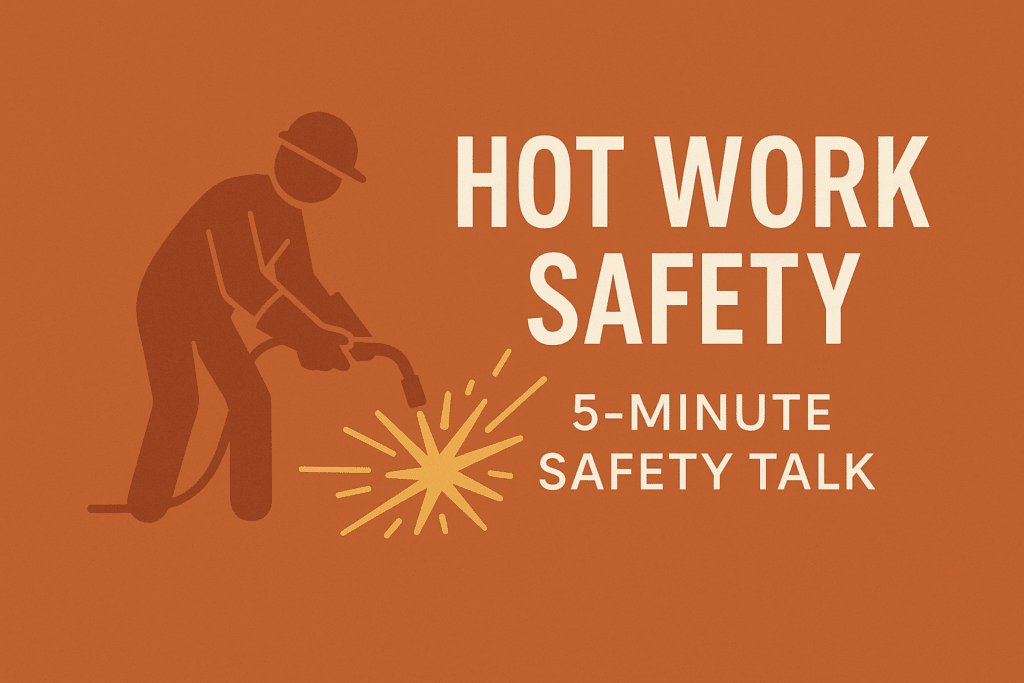
Hot Work Safety 5 Minute Safety Talk
Good morning team,
Today we’re going to talk about a task that’s high-risk and demands serious attention—Hot Work.
Hot work includes operations like welding, cutting, grinding, brazing, soldering, or using torches—basically, anything that produces sparks, flame, or high heat. These activities are essential, but they also bring one major danger: fire.
In fact, hot work is one of the leading causes of workplace fires, especially when done without proper precautions. So, let’s take five minutes to walk through how to perform hot work safely and responsibly.
What Is Considered Hot Work?
Hot work includes:
- Welding or arc cutting
- Oxy-fuel cutting or burning
- Soldering and brazing
- Grinding and chipping (if sparks are produced)
- Use of torches or heat guns
- Work near flammable or explosive materials
If it generates heat, sparks, or flame—it’s hot work.
Common Hazards of Hot Work
- Fires or explosions due to flammable vapors, gases, or materials nearby
- Burns from direct contact with hot metal or equipment
- Eye damage from UV or infrared radiation
- Inhalation of harmful fumes or gases
- Confined space hazards if hot work is performed in enclosed areas
Hot Work Permit – Don’t Start Without It
Before starting any hot work, you must have a valid Hot Work Permit.
The permit ensures:
- The work area is inspected for fire hazards
- Fire watch personnel are assigned
- Flammable materials are removed or protected
- Proper fire extinguishing equipment is available
- Time limits and safety procedures are defined
No permit, no hot work—no exceptions.
Fire Watch – Your Frontline Defense
A fire watch is mandatory during hot work and for at least 30 minutes after the task ends (or longer if required).
The fire watch must:
- Stay focused—no other duties allowed
- Be trained in using fire extinguishers
- Know emergency procedures
- Monitor for smoldering sparks or flare-ups
A distracted fire watch is no fire watch at all.
Safe Work Practices for Hot Work
- Remove flammable liquids and gases from the area
- Use fire blankets or welding curtains to shield surroundings
- Sweep floors clean of dust, paper, or oily rags
- Ventilate the area to avoid fume buildup
- Never do hot work near combustible insulation or paint
- Know the location of the nearest extinguisher and alarm
PPE for Hot Work
Always wear the proper personal protective equipment:
- Welding helmet or face shield
- Flame-resistant clothing (FR rated)
- Leather gloves
- Safety boots with metatarsal protection
- Respiratory protection if fumes are present
- Earplugs or muffs in noisy environments
PPE isn’t optional—it’s your last line of defense.
Ventilation Matters
Hot work often produces toxic fumes and gases—especially when cutting coated metals or in confined spaces.
To protect yourself:
- Use mechanical ventilation or fume extraction units
- Avoid working in enclosed spaces without air monitoring
- Use appropriate respiratory protection
Inhaling toxic fumes is a silent hazard—don’t take it lightly.
Safe Material Storage
Flammable and combustible materials should be stored:
- In approved containers
- Away from the hot work area (ideally 35 feet or more)
- With spark-proof barriers or fire-resistant blankets in place
If you can’t move the material, shield it completely.
Real-Life Example
A welder in a maintenance area started grinding without checking the surroundings. Sparks flew into a nearby trash bin filled with oily rags. Within minutes, the entire corner was on fire.
No fire watch. No extinguisher. No permit.
Result? Major equipment damage and two workers hospitalized with smoke inhalation.
It was 100% preventable.
Everyone Plays a Role
- Supervisors must enforce permit procedures
- Fire watch personnel must stay alert
- Workers must inspect the area, use PPE, and follow protocols
- Safety teams must train, inspect, and monitor compliance
Hot work safety is everyone’s job, not just the welder’s.
Know When to Stop
Stop work immediately if:
- You lose visibility
- Your PPE is damaged
- The fire watch leaves
- You smell gas or chemical fumes
- Alarms go off
Your safety is more important than rushing a task.
Conclusion
Hot work is essential—but also extremely hazardous. With the right precautions, a clear permit process, and constant awareness, you can perform hot work without injury or fire.
So remember:
- Always get a hot work permit
- Use fire-resistant shields and PPE
- Assign a proper fire watch
- Clear the area of flammables
- Never take shortcuts
Because when it comes to hot work—you only get one chance to get it right.
Safe Lifting Techniques 5 Minute Safety Talk
Slips Trips and Falls 5 Minute Safety Talk
Fire Safety 5 Minute Safety Talk
Electrical Safety 5 Minute Safety Talk
Personal Protective Equipment – PPE 5 Minute Safety Talk
5 Unique FAQs
Q1: How far away should flammable materials be kept during hot work?
At least 35 feet—or fully shielded with fire blankets or barriers if they cannot be moved.
Q2: How long should the fire watch stay after hot work ends?
At least 30 minutes, or longer if stated in the permit or based on risk.
Q3: Can hot work be done near a fire extinguisher alone, without a fire watch?
No. A trained and dedicated fire watch is mandatory during and after hot work.
Q4: Is a hot work permit needed for grinding metal outdoors?
Yes—if it creates sparks, a hot work permit and precautions are still required, even outdoors.
Q5: What should I do if my FR clothing catches fire?
Stop, drop, and roll immediately. Call for help and seek medical attention right away. Never remove PPE near open flame.